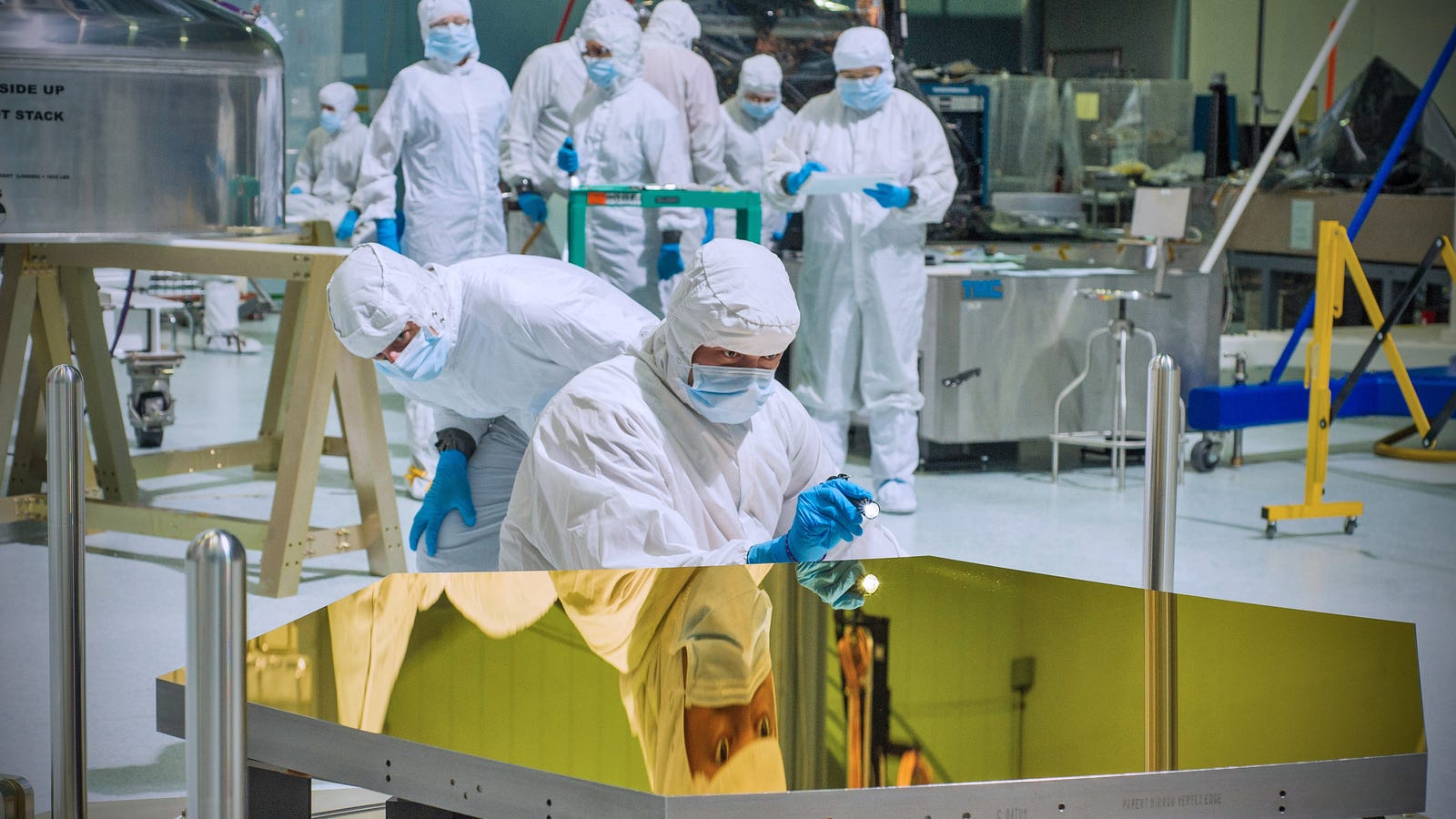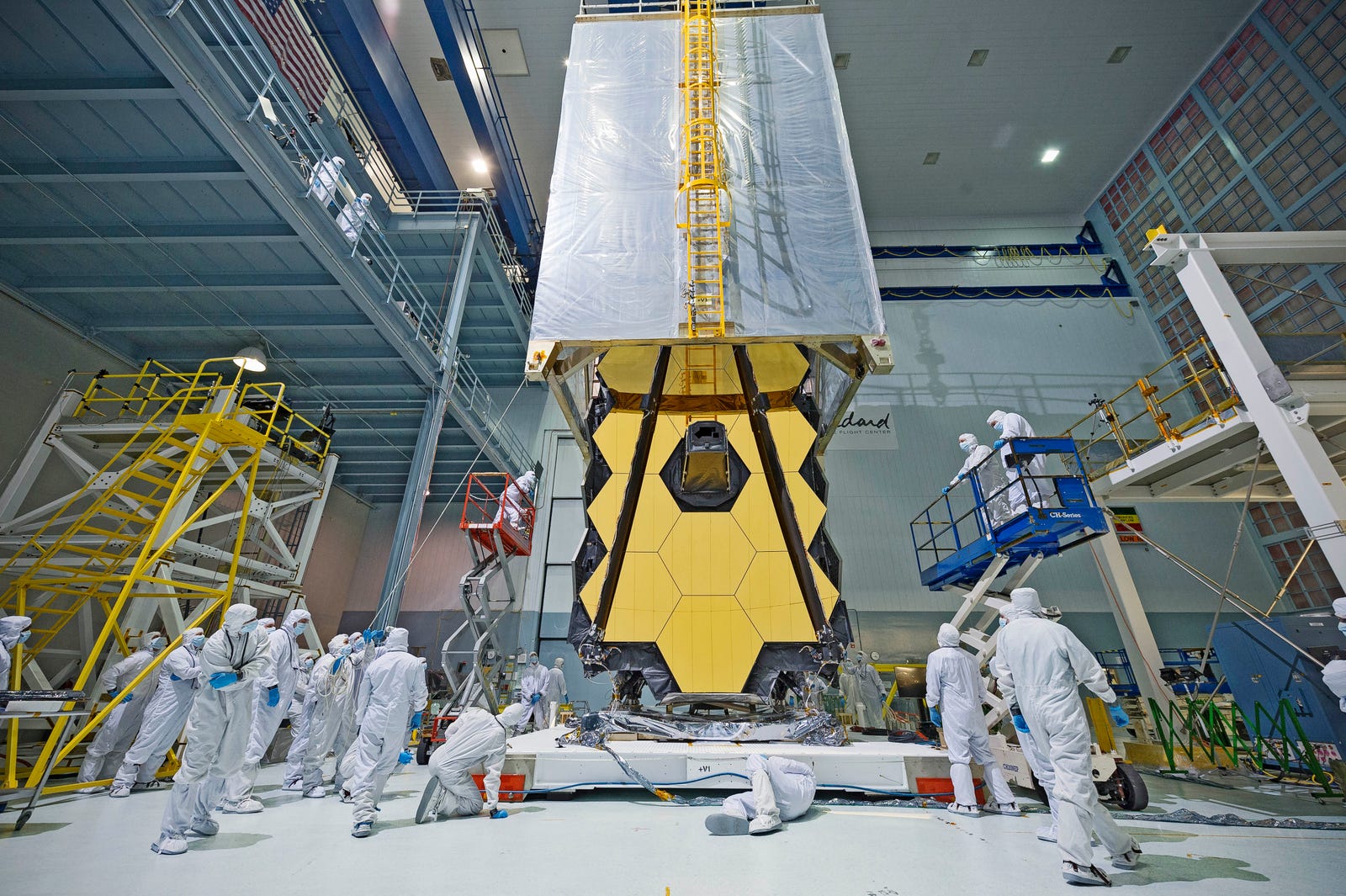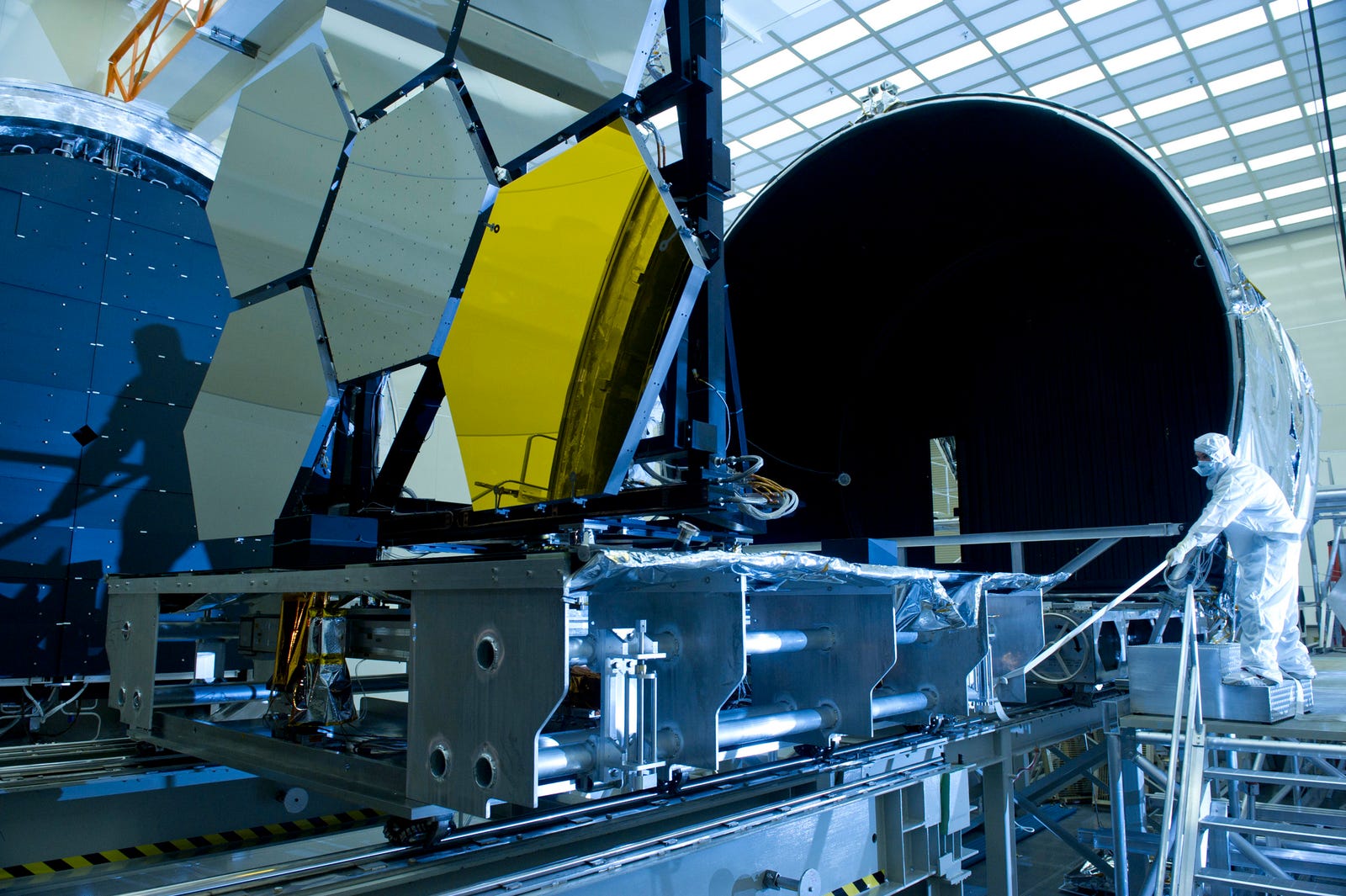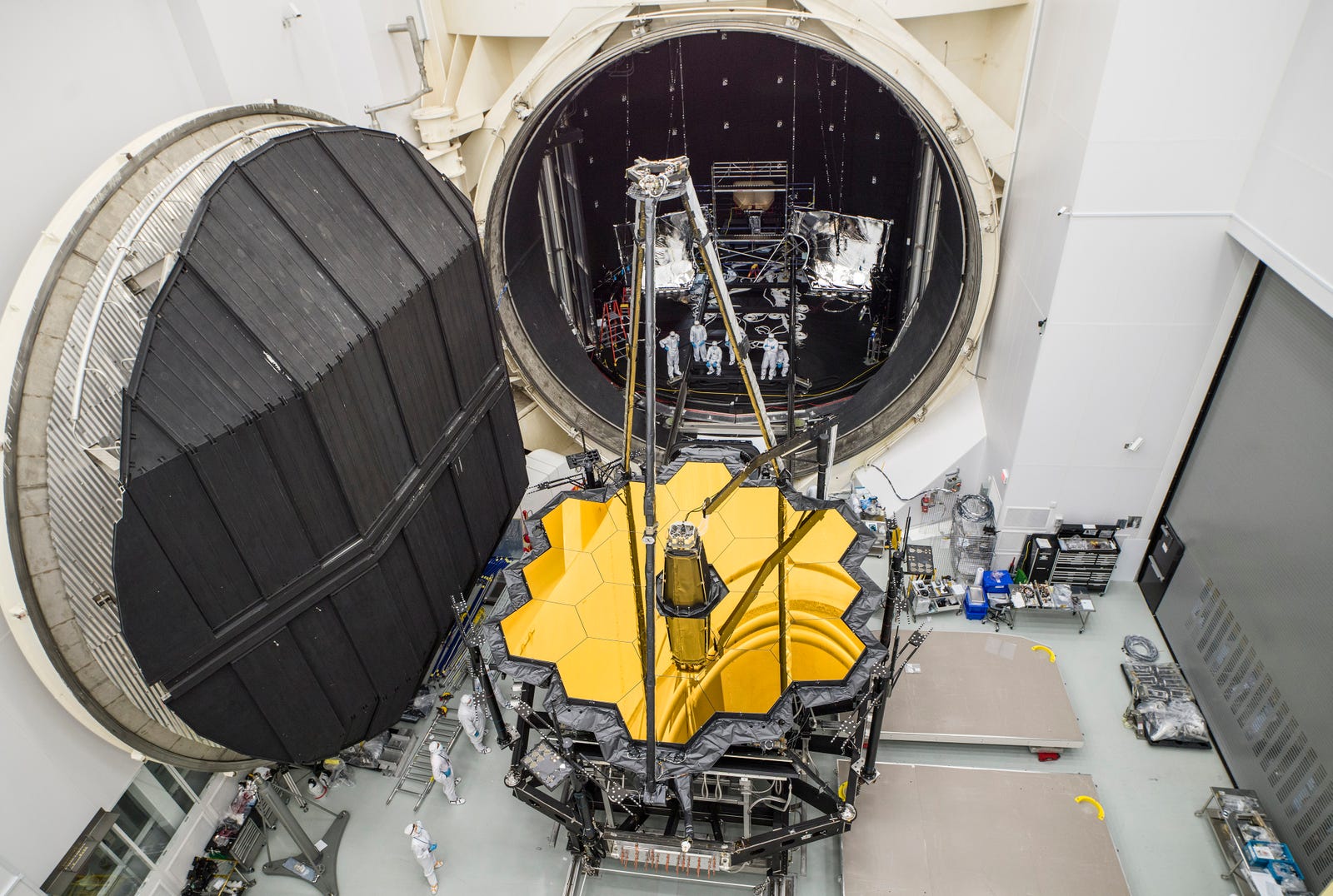
[ad_1]
For nearly 20 years, NASA has been planning and constructing a telescope unlike any ever built before: the James Webb Space Telescope. It will change the way scientists see the most distant galaxies and intensify the hunt for extraterrestrial life; it will answer outstanding questions about the birth and death of stars and planets. It is the future of astronomy—but it’s causing trouble. JWST’s high price and decade of delays could stymie the development of future telescopes, impacting the course of astronomy for the next 30 years.
Billed as a successor to the Hubble Space Telescope, the JWST is a tennis court-sized, general-purpose space telescope with a 6.5-meter (21-foot) mirror that will be sent to a gravitationally stable point nearly a million miles from Earth. It will create incredibly detailed images from the infrared light of objects in space, including nebulae, exoplanets, galaxies, and stars. Looking even further ahead, NASA’s planned successor to JWST, called the Wide Field Infrared Survey Telescope (WFIRST), will observe the sky with resolution similar to Hubble’s but with a far wider field of view. That would allow astronomers to answer some of the fundamental questions about dark energy, a mysterious force that seems to be driving the universe’s accelerating expansion. It would also provide a platform to test state-of-the-art components for its own successor. Four teams of scientists are already working on different concepts for the flagship mission to follow WFIRST, which would launch in the 2030s or 2040s. Three of those concepts would follow up on potentially life-harboring exoplanets spotted by JWST, while the fourth would aim to understand the origins of galaxies and the universe itself. These missions would all be expensive, similar in cost to JWST.
“[Today’s astronomers] are the first humans in history that have a chance to answer the compelling questions about whether there is life beyond Earth,” MIT astrophysicist Sara Seager recently told the Senate.
But as the JWST’s price tag has increased incrementally, from hundreds of millions of dollars to $9.6 billion, some scientists working on its successors are uneasy. Where does the extra money come from to pay for JWST’s budget overruns, and how have these delays affected public perception of these large missions? And if NASA scraps or removes certain parts from WFIRST, that might handicap future space-based efforts to detect signs of life outside the Solar System. While Congress views astronomy research more favorably, President Trump’s 2019 budget request has already suggested scrapping WFIRST.
As of now, the future of these missions and how JWST will impact them is uncertain, Scott Gaudi, Ohio State University professor and member of the WFIRST team, told Gizmodo.
As early as 1989, astronomers had an early concept of JWST as a “Next Generation Space Telescope,” the successor to Hubble. While originally envisioned as having a mirror eight or more meters (26+ feet) in diameter, budget constraints caused scientists to de-scope various goals, resulting in the 6.5-meter (21-foot) telescope concept that would become the James Webb Space Telescope. As plans developed, NASA in 2002 selected an aerospace company called TRW to build the spaceship and mirror with an $825 million budget and a scheduled launch in 2010. Northrop Grumman acquired TRW, and soon took over the telescope’s construction.

Delays have marred JWST’s entire developmental history. Most recently, an independent review revealed that increase in project scope, the complexity of the telescope, overoptimism, and human errors have plagued its construction. Those human errors include the time when someone at Northrop Grumman used the wrong solvent to clean valves, and the time when loose nuts fell into the telescope during a test, according to the review. But as early as 2005, the launch had been pushed to 2013 and the cost to $4.5 billion due to “funding shortfalls,” “requirement changes,” and other issues. Fabrication began in 2011, but by then the launch was pushed to 2018 and the budget to an estimated $8 billion. Today, the JWST’s estimated cost is up to $9.66 billion, and its projected launch date is some time in 2021.
Then there’s the mere fact that huge advances in astronomy have occurred during the telescope’s development. NASA administrator Jim Bridenstine explained in a Congressional hearing this past July that the study of today’s most ubiquitous astronomy topics, like dark energy and exoplanets, was only beginning when the JWST project began. “This isn’t simply mismanagement or cost overruns or delay,” Congressman Don Beyer (D-Virginia) said during the hearing. “The world of science itself is changing in ways that have impacted the project.” Essentially, the price and scope of the project have expanded as scientists have learned more about the universe and encountered more cosmic mysteries.
By 2010, it was already time to plan a successor for JWST. Every decade, committees of scientists survey the state of astrophysics and decide what kind of experiments the entire community would like to see next, including small- and medium-sized missions as well as the flagship missions. For the largest missions, teams of scientists work on multiple concepts, and the Decadal Survey committee uses these concepts to set the field’s priority for NASA.
Even back then, astronomers worried about how JWST’s cost would affect the future of observation. But then NASA received a 2.4-meter (7.8-foot) mirror from National Reconnaissance Office (NRO). The mirror was initially designed for use in espionage, but would work nicely in a space telescope. The Decadal Survey moved forward with a telescope called WFIRST—a telescope with Hubble’s resolution but 100 times the viewing area. A telescope like this would help scientists determine the true nature of dark energy, a mysterious force that seems to be speeding up the universe’s expansion and that could determine the universe’s ultimate fate. NASA scrapped other concepts, like the exoplanet-hunting Space Interferometry Mission, in response.
WFIRST “was a Frankenstein creation,” Jessie Christiansen, astrophysicist at the NASA Exoplanet Science Institute at Caltech, told Gizmodo. “It was something no one really asked for until they got the mirror donated by the NRO.” But, according to the Decadal Survey, such a telescope would “settle essential questions in both exoplanet and dark energy research, which will advance topics ranging from galaxy evolution to the study of objects within our own galaxy.” WFIRST has expanded in both scope and cost since the 2010 decadal survey.
The telescope’s wide-field surveying instrument would be relatively simple compared to some instruments flown on previous NASA missions, Gaudi told Gizmodo. But WFIRST would also be the first to fly a technology in space that is important for two proposals for the next flagship space telescope: a “coronagraph.” A coronagraph is a device that blocks stars’ bright light, making the dimmer planets orbiting the star visible. If scientists hope to find life around other stars, they’ll need to image the light produced by and reflected by the planet directly. The issue is that the planet may be billions of times dimmer than the star it orbits. Scientists hope to one day spot Earth-like planets using this technology.
And here’s the most important part: Observing the light directly from planets, rather than just observing the periodic dimming produced when the planet passes in front of its star, could tell scientists whether the presence of life has altered the planet’s atmosphere the way it has on Earth. Climate change aside, life fills Earth’s atmosphere with carbon dioxide, oxygen, methane, and other biological building blocks. Therefore, determining whether life exists on other planets requires observing these planet’s atmospheres to see what molecules they contain.
Preparations for the 2020 Decadal Survey are already underway. Four teams of astronomers are preparing concept studies for WFIRST’s successor, a flagship telescope mission that would launch some time in the late 2030s or early 2040s. As happened in 2010, the survey will determine what astronomy’s most important scientific questions are, and how best to answer them using ambitious, potentially yet-to-be-developed technology. The decadal committee will move forward with a recommendation based on the goals and design of one or multiple concepts. It’s clear that hunting for signs of extraterrestrial life will play an enormous role in the discussion. Two of the concepts incorporate a coronagraph like WFIRSTs, and three list analyzing exoplanets among their primary goals. All of them would cost billions of dollars.
The Large UV/Optical/IR Surveyor (LUVOIR) is the most ambitious of these four missions—and it would be truly enormous, with either an 8- or 15-meter (26- or 49-foot) mirror. It would be a sequel to JWST. Another, the Habitable Exoplanet Imaging Mission (HabEx), is built from the bottom up with observing exoplanets in mind. Both would rely on a coronagraph and a starshade, an external component that blocks the light of other stars.
Two other proposed telescopes wouldn’t rely on a coronagraph or a starshade. The Origins Space Telescope (OST) would look for exoplanets around cooler stars in the infrared wavelengths, where the difference in brightness between the star and planet isn’t as great. Its goals also include observing the formation of planets and the growing complexity of stars and galaxies. Finally, there’s Lynx, which is instead focused on high-energy astrophysical mysteries, such as the dawn of black holes and the birth and death of stars. It would be an x-ray telescope using sensitive instruments, and serve as the sequel to the wildly successful Chandra X-ray Telescope.
The National Academy of Sciences has already hinted that it favors a telescope equipped with a coronagraph or some sort of starlight-shading device, like LUVOIR or HabEx, when it comes to hunting for extraterrestrial life. From the recent Exoplanet Science Strategy report:
A coronagraphic or starshade-based direct imaging mission is the only path currently identified to characterize Earth-size planets in the habitable zones of a large sample of nearby Sun-like stars in reflected light… NASA should lead a large strategic direct imaging mission capable of measuring the reflected-light spectra of temperate terrestrial planets orbiting Sun-like stars.
Another more recent report from the National Academies outlining a strategy for the future of astrobiology calls starshades and coronagraphs “essential.”
It’s important to note that there a host of other Earth-based telescopes under development, like the Giant Magellan Telescope and the Thirty Meter Telescope. These ground-based telescopes are better for observing planets around cooler, small M-dwarf stars, Aki Roberge, scientist at the NASA Goddard Space Flight Center working on LUVOIR, recently told Gizmodo. Space telescopes equipped with starlight-blocking coronagraphs could better observe planets around Sun-like stars. Extraterrestrial life might exist on either, and both are part of a healthy astrobiology strategy.
The decadal space telescope proposals are already beginning to feel the heat from JWST. On June 1, NASA astrophysics director Paul Hertz emailed the concept teams, imposing a $3 billion to $5 billion cost goal for the studies. According to a press release, “With recent delays and budget constraints surrounding the two major flagship missions, the new direction will better ensure that the next flagship mission be executed on time and within budget.” However, he revised that memo two weeks later, and instead reminded teams that the second phase of their design process was beginning in which they should design a less costly architecture than their first designs. The National Academies has also recommended that these concepts think about cost and schedules. These concept studies are due to NASA by June 2019.
Some, like LUVOIR physicist John O’Meara, worry that the difficulties with JWST will cause members of the astronomy community to give up on large missions such as these in general. It’s a sentiment that some, like former NASA administrator Charles Bolden, have expressed before. “I hope they don’t do that,” said O’Meara.

“I’m really concerned about the state of funding,” Laura Lopez, assistant professor at Ohio State University working on the Lynx team, told Gizmodo. “It feels like a precarious situation where we don’t know what will happen next year, let alone in the next 15 years.” Any large missions like these would require sustained funding for more than a decade.
And there are plenty of smaller missions whose futures might be in jeopardy due to the cost and scope of these larger projects, missions of a similar scope as Kepler and TESS.
JWST could impact these future missions directly or based on how it affects WFIRST. This past summer, Congress has held hearings grilling NASA and Northrup Grumman about the JWST’s cost overruns and delays. Northrup Grumman CEO Wes Bush told Congressman Lamar Smith (R-Texas) that the company would not pick up the most recent $800 million cost increase. It’s unclear what will happen next.
WFIRST faces clear threats. This past year, President Trump’s proposed budget included scrapping the telescope entirely. Scientists are confident that the more space-friendly Congress won’t let that happen, but Gaudi has heard talk threatening the existence of the coronagraph as well. Should WFIRST lose its coronagraph, scientists will miss an important opportunity to try the light-blocking technology out in space before flying it on the ultimate exoplanet-hunting telescope.
Gizmodo heard several times that flying a coronagraph without testing it on some previous mission could be a very bad idea with far-reaching implications on cost and schedule. “We may save roughly $300 million by de-scoping a coronagraph,” David Spergel, Princeton astrophysicist working on WFIRST’s development, told Gizmodo, “but I suspect in the long run, it could cost a billion in development cost of LUVOIR or HabEx when the time comes to upgrade to a coronagraph capable of detecting Earth-like planets.” Gaudi said that flying a coronagraph on WFIRST would make LUVOIR or HabEx “much more palatable to pretty much everyone.”
Scientists have reminded Congress as to the coronagraph’s importance. “WFIRST’s coronagraph instrument is a technology demonstration,” Seager said recently at a Senate hearing. “It’s critical to do this to buy down more ambitious missions in the future already under study.”

For what it’s worth, the astronomers Gizmodo spoke with generally agree that JWST will be well worth the wait. But flagship telescopes are meant to advance significantly upon existing instruments—and improvement requires money. Scrapping or de-scoping WFIRST could further delay humanity’s dream to spot life on other planets, should the Decadal Survey ultimately decide to recommend a coronagraph-based mission. So, too, could fear or budgetary consequences stemming from the JWST delay.
Of course, what happens next with WFIRST is up in the air. Scientists are waiting to see what happens with the reconciliation of upcoming budgets, “and how Congress will respond to the additional delays of JWST,” said Gaudi. Given the country’s chaotic political climate, no one knows what will and won’t get funding in the future. But long-term investments require money—and representatives who are willing to allocate that money to support them.
“I’m just doing my best to provide Congress with as much information as I can so they make the best possible decision,” said Gaudi. “I hope they are ambitious and optimistic about the science.”
Source link